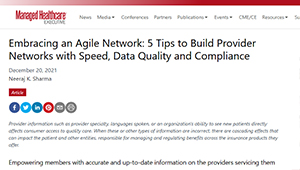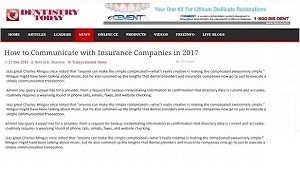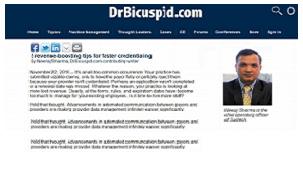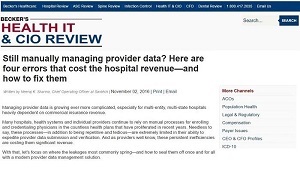


Empowering members with accurate and up-to-date information on the providers servicing them is vital for payers.
Provider information such as provider specialty, languages spoken, or an organization's ability to see new patients directly affects consumer access to quality care. When these or other types of information are incorrect, there are cascading effects that can impact the patient and other entities, responsible for managing and regulating benefits across the insurance products they offer.
For payers, this is a critical time to build out their provider data teams and establish an agile infrastructure. The Centres for Medicare & Medicaid Services (CMS) has stated that nearly 50% of all provider directory locations contained at least one inaccurate piece of provider data, regardless of the focus on provider directory accuracy.
These errors contribute significantly to numerous instances that impede an efficient healthcare experience, like when patients visit doctors at the wrong locations, dial phone calls on incorrect phone numbers to make an appointment, or join a health plan without realizing that their existing clinician does not participate in the network.
Major outcomes of inaccurate provider data
As a result of inaccuracies, these situations directly impact patient satisfaction and trust.
Payers must manage and enhance provider data quality to avoid member dissatisfaction or ultimately losing them. Besides, poorly managed provider directories can cause delays in reimbursement, increased administrative costs, or frustration for payers, providers, and networks.
Some of the areas of noted data inaccuracies are providers listed at the wrong location, incorrect phone numbers, providers not accepting new patients when the directory indicated they were, wrong suites, and incorrect specialties.
Additionally, provider data changes at a rate of 2 to 2.5% every month, which means that payers need to stay on top of their business.
Below are five sure-fire tips for payers to build provider networks with speed, data quality, and compliance.
1.) Build a single source of truth
Ensuring that different teams within payer’s staff are working off the same playbook of Provider information is a continuous challenge for health insurers but ultimately serves as a key to success.
Currently, multiple teams build their own provider data silos, and that information is subsequently updated by different stakeholders in different systems. In recent years, the scrutiny around this data has increased due to compliance issues, so now if an insurer has a single source of truth, an update can apply in one place and that system will supply the data to other sources, removing the room for error.
Besides enforcing provider data quality, working off a singular information set rather than multiple touch points can help improve compliance and strengthen relationships with providers and patients.
2.) Validate provider data proactively
Much like establishing a single source of truth, payers need to be wary of multiple systems inputting data simultaneously. Health plans need to take the task upon themselves of filtering through the available information to assess bad, incomplete, or inaccurate information during data loads.
The complicating factor in this equation is that payers often don't have the existing infrastructure to conduct this constant monitoring, which is far from a manual task.
Payers should be performing aggregate-based validations and verifications of subject areas, to proactively identify data issues. This can be accomplished through continuous source-to-source verification (both internal and external systems), data-issue tracking, and efficient workflow management to help validate provider data immediately.
If not, bad data can serve as the basis for incorrect strategies and decisions related to network expansion and other changes. Downstream, this inevitably results in pending claims as well as unhappy providers and consumers discovering a provider doesn't meet their needs at all.
3.) Conduct Continuous data quality checks
Payers have a hugely important task on this front: find out what important data set is missing or changing. Given the network size and number of changes coming from providers in varied forms, this cannot be achieved manually and can only be accomplished if payers have the appropriate system in place, which keeps them up to speed with changes rather than playing catch-up.
An efficient network management system keeps an eye on every critical part of provider information and ensures the change follows its designated lifecycle for completion before getting passed on to the claims, directory, or care management system.
The problem is that most payers are not conducting these data quality checks as it requires significant human efforts and is only doing so on an either ad hoc basis or an as-needed basis. That must change.
Health plans would benefit from conducting monthly data quality checks to ensure the accuracy, relevancy, completeness, and timeliness of provider data.
4.) Collaborate with providers
As healthcare pivots from the worst of the COVID-19 pandemic, there are substantial opportunities to repair the relationship between payers and providers. Collaborating to improve the communication and dissemination of provider data is one such area of mutual concern.
Through an accessible online portal, providers can update their information and give payers a reliable dataset for their operations. There should also be a consideration for establishing a practice administrator portal where practice administrators can update their provider records as well.
5.) Embrace CMS Mandated Provider Directory APIs
This is an even more important consideration in light of CMS' decision this summer to begin enforcement of requirements for certain payers to support Patient Access and Provider Directory APIs. Instead of looking at this situation as a compliance issue, payers should view it as an opportunity to work better with providers in an effort that data points are accurate. For years, both sides have sought common ground and now this regulatory obstacle can serve as the building ground for one.
Payers should employ provider network management infrastructure which is ready with API toolkits for providers to submit directory changes, seek confirmation through APIs. Agile network management equipped with API gateway configurations, can launch, monitor, and scale this operation.
Additionally, payers should try to use this opportunity to go over and beyond the CMS mandated requirements for APIs and allow larger groups to submit new provider enrolment, re-credentialing information, and directory attestation through APIs to build an edge for their business.
The soul of every health plan
Employing an agile provider network management solution can enhance data management capabilities that can help build better relations with providers and better networks in record time.
A payer's agility comes from how quickly they know that the source is capable of taking data, matching the data, cleaning the data, and applying necessary updates. An intelligent dataset supports the ability of all stakeholders to access and update data.
The current process for payers to launch a new network is too slow and involves going through so many manual steps. Breaking that cycle and moving towards network management that values low costs and improved outcomes is an ideal endpoint in the modern healthcare landscape.
It's clear that the fast-paced business environment, combined with human error, bears inaccurate and fragmented provider data for payers. Because of this dynamic, health plans must be vigilant about constantly updating provider data points for best practice.
Payers currently get provider data from many sources, comprising provider group rosters, claims, as well as credentialing and contracting processes. Unfortunately, no one source contains the complete truth. Hence, it's vital to identify the authenticity of sources, the friction between them, and which sources are most reliable for which data elements.
It's a worthwhile endeavour to pursue a diversified approach to provider data management, including cross-industry touch points, referential data, and claims analytics. Businesses that consider data as an asset and optimize their data management capabilities will be more insightful and offer quality care to their consumers.
Emphasizing a singular, data-driven truth can eliminate inaccurate provider data that leaves enormous gaps in an organization's ability to render quality care to patients. Data is central to all health plan processes and needs to be always kept top of mind to ensure a strong foundation with which to work. Embracing these best practices of provider data management quality has the potential to correctly enforce provider data quality across the enterprise, boost productivity, compliance, and improve the patient experience.

Jazz great Charles Mingus once noted that “anyone can make the simple complicated—what’s really creative is making the complicated awesomely simple.” Mingus might have been talking about music, but he also summed up the lengths that dental providers and insurance companies now go to just to execute a simple communication transaction.
Almost any query a payer has for a provider, from a request for backup credentialing information to confirmation that directory data is current and accurate, routinely requires a wearying round of phone calls, emails, faxes, and website checking.
It’s a huge burden on the dental provider’s time and resources, but no longer an insurmountable one. Many dental organizations are making the ingenious move to let automated tools do all this “talking” instead, processing unlimited volumes of payer requests at breath-taking speed.
Still, as efficient as these tools are, it’s essential to keep in mind that they supplement rather than supplant human interaction. With that, let’s delve into the top communication tactics to take with insurance companies in the year ahead, aided by provider data management technology.
Catalog Your Insurance Company Contacts
This can’t be said enough: dental organizations that fulfill requests for information in a consistent, structured manner are the ones that insurance companies want to deal with. With so many dental providers to reach out to, there’s never going to be one dedicated person at an insurance company just waiting to receive and process information from your practice. So, don’t throw your information out there thinking that people will have the time and inclination to extract from it what they need.
Instead, take the lead in making information gathering and processing as simple as possible for insurance companies. Begin by cataloging every health plan you participate in. Then include the insurance company rep’s contact information for each plan; very often, you may have more than one rep for different functions such as credentialing and provider directory updates. Be sure the rep and his or her role is clearly distinguished to avoid wasting time reaching out to the wrong person. Lastly, include each provider that is associated with the plan.
Centralize and Standardize Communication
Obviously, the above tactics are only effective if everyone follows them, so make sure that your staff have the insight to do so. Designate a single, central location from which to manage communication with insurance companies. This will be the same place you keep the above information about health plans, plus all your provider enrollment, credentialing, and directory data.
There are provider data management systems that store all this information. Those that are internet-based or cloud-based will offer a true centralized “hub” for multi-location practices. Even more, they can automate much of the work involved in fulfilling insurance requests. This includes “one and done” data inputting that automatically populates related data fields across different forms; duplicate record scrubbing; and the ability to send insurance companies documentation right from the provider data management system itself.
Note that once such capabilities are in place, dental practices no longer feel they have to save up batches of enrollment, credentialing, and provider directory tasks to process. This isn’t a recommended best practice, either. Insurance companies don’t want to process a bulky batch of requests any more than you want to tackle a separate new one every day.
Close the Loop
When you’ve completed a transaction, make sure both you and the insurance company consider it closed. This will be helpful on a couple of different levels. First, it will keep everyone in your dental practice or services organization on the same page about where your provider data activities stand with each insurance company. Second, it will serve as an evidence trail for proving that your organization did indeed complete or otherwise comply with an insurance company’s request. So if you’ve sent updated information on three different providers, or a copy of a provider’s license, or anything else the insurer requested, ask for confirmation that it was received. Then make note of this confirmation.
Of course, as we know, communication with payers never really ends. Just as soon as a directory is updated or provider is credentialed, it will be time to renew the information for both. With that, here’s one last tip: make sure your provider data management system has automatic reminders built in for upcoming expirations. Such a system, paired with the tactics above, can make the business of practicing dentistry much simpler. Make that awesomely simpler

Its an all-too-common occurrence. Your practice has submitted sizable claims, only to have the payor fully or partially reject them because your provider isnt credentialed. Perhaps an application wasnt completed or a renewal date was missed. Whatever the reason, your practice is looking at more lost revenue. Clearly, all the forms, rules, and expiration dates have become too much to manage for your existing employees. Is it time to hire more staff?
Hold that thought. Advancements in automated communication between payors and providers are making provider data management infinitely easier, significantly reducing administrative burdens and risk to the dental practices revenue. No longer do dental organizations have to depend on specialized staff knowledge to oversee credentialing. Instead, theyre putting automation to work in the following five areas.
1. Managing documentation in one central hub
Its well-known that the credentialing process can take upward of 20 weeks for a single provider -- and the larger the organization, the more convoluted this process becomes. For example, organizations with multiple offices may find that staff is working from its own understanding of whats needed to credential their dentists and using different systems, processes, and data files.
By contrast, hosting and managing all payor enrollment documentation within one cloud-based hub ensures that all facilities adhere to the same standards and are working off the latest information. Now staff from different locations -- including different states -- have a single source of truth to identify the correct payor applications and checklists of supporting documentation. Such a system will forever banish the questions of Is this the right form? and Is this the most current data?
2. Ending duplicative work by autopopulating data
Enrolling in even just one dental health plan requires the completion of copious forms, much of it information that must be resubmitted for the next plan -- and the next. Such repetition is inefficient for the dental organization as a whole, and it prevents staff from focusing on higher value functions, such as offering superior customer service.
The good news is that data autopopulation is a key feature of an advanced provider data management platform. Now common fields such as dental provider contact information, specialty, and others need only be completed once for replication across countless credentialing forms.
Also, look for platforms that offer a single-hosted forms library. When changes are made to a form in this library, all dental practices that use this form are notified. Practices still have the flexibility to edit these forms to address special needs.
3. Making use of e-signatures
Automation also makes it possible to use electronic signatures in lieu of printing off a document for a handwritten signature, then scanning and uploading the document back into the system to be emailed. Its a seemingly minor benefit -- but one that saves time. Be sure to check with payors first, however, to confirm that they accept e-signatures. Most do from a trusted platform.
4. Using smart prompts
"In the absence of a modern provider data management system, staying ahead of disparate payor rules is a constant challenge."
Even automated provider data management requires proactive human intervention. However, this can be greatly aided by more automation -- that is, automatic prompts and alerts for recredentialing deadlines and other attendant activities.
The importance of this benefit cant be overstated; missing such deadlines can and do result in providers failing to be enrolled or re-enrolled in a health plan. As alluded to earlier, its an unpleasant discovery often made by way of a denied claim -- and lost revenue.
5. Keeping an evidence trail
In the absence of a modern provider data management system, staying ahead of disparate payor rules is a constant challenge. Here is where a provider data management platform becomes a powerful weapon, not only with automatic prompts and uploading of the latest applications and requirements, but also with audit trail functionality. Contracts, effective dates, and other information can prove compliance and are easily found and referenced when stored in a central hub.
This is a particularly welcome feature for proving dates of application submissions. Indeed, in my experience, some practices have been known to win back six-figure sums in previously denied claims by producing a well-documented evidence trail.
Having documentation trails is also helpful when someone who used to handle credentialing in your office is replaced by someone else. Now the new employee need only check the documentation trail in the platform to see where he or she needs to resume the credentialing process.
With dentists participating in an ever-increasing number of dental plans, manual credentialing is quickly becoming obsolete. By replacing it with a modern provider data management platform, dental organizations can quickly and easily enroll in more plans and enjoy the attendant new efficiency and revenue.

Managing provider data is growing ever more complicated, especially for multi-entity, multi-state hospitals heavily dependent on commercial insurance revenue.
Many hospitals, health systems and individual providers continue to rely on manual processes for enrolling and credentialing physicians in the countless health plans that have proliferated in recent years. Needless to say, these processes—in addition to being repetitive and tedious—are extremely limited in their ability to expedite provider data submission and verification. And as providers well know, these persistent inefficiencies are costing them significant revenue.
With that, lets focus on where the leakages most commonly spring—and how to seal them off once and for all with a modern provider data management solution.
Provider data is stored in disjointed and multiple systems across different departments. This is a recipe for problems such as outdated provider directories, denied claims, patient dissatisfaction and other serious issues that threaten a healthy revenue flow. The solution: house data in a central hub that updates and synchronizes provider data across every department that relies upon it. Such automation is an essential feature of a robust provider data management system, equipping provider organizations with a proverbial single source of truth—at least regarding physician data.
Upon implementation, hospitals and health systems immediately benefit from the elimination of time-consuming repetition. More permanently, denied claims become fewer and farther between. Of course, such a central hub must have the technological capability to easily integrate with other systems, departments and even external data sources.
There is no system of checks and balances to easily review and confirm that provider data is accurate and up-to-date. This one deficiency can seriously delay provider onboarding to new plans, with the domino effect of related delays in reaping revenue. So while a central hub goes a long way in managing, changing and updating data across the healthcare organization, an advanced data management platform should also include features that flag and notify enrollment and credentialing staff when these activities need to be done and for which physicians. Further, these alerts should be proactive, based on state regulations, payer (commercial or government) rules and physician specialty.
Importantly, a provider data management system that keeps these rules continuously updated is a smart and efficient replacement for the old way of entrusting this information to staff within disparate departments.
No ability to simultaneously update provider data across different plans. It is not uncommon to take weeks or longer to enroll providers in a single plan. Most organizations simply arent equipped to handle provider enrollment at scale, or at least to collect, verify and submit provider data across different plans. As such, enrollment applications frequently come back to the provider requesting more information. Inevitably, this sets off a chain of phone tag, emails and other attempts between payer and provider to confirm, send and receive the needed information. No wonder enrollment can stretch out over months! And its a process that providers have to repeat over and over for different payer networks and health plans, for each physician. This may not significantly affect the payer. But it will negatively impact the financial health of the hospital or health system. The key question is: how can this process be accelerated?
The best way is with a provider data management solution that standardizes and auto-populates provider data, such as contact information, specialty, locations, ability to receive new patients and more, across different plan applications. It will essentially perform a paperless review of credentialing verification activities, cutting through repetition with centralized document management, automated electronic signatures, integration with third party provider verification services and more.
As an added bonus, a centralized system for provider data management automatically tracks all activities done for each credentialing and enrollment assignment—valuable proof if needed to challenge a denied claim. This backup exists regardless of staff turnover, with no one person holding this specialized knowledge.
Post-credentialing, provider data integrity lapses. Manual enrollment and credentialing is such a drawn-out process, its no wonder that some hospital departments take a once-and-were-done perspective of these two necessary tasks. Yet this operational philosophy will undoubtedly lead to outdated provider directories, which then results in unhappy patients who wont be back for services, even if they are deemed in-network. In short, completion of credentialing isnt the end of the story. Providers should stay on top of the plans in which they are enrolled so that they dont lose participation without knowing it.
Here again, a centralized, automated, rules-based provider data management system can keep providers current with a practically unlimited number of plans, at a fraction of the time that manual processes used to require. Now staff members can be reassigned to high-touch functions that require more human intervention and follow-up. Indeed, with a modern data management platform facilitating the vast majority of the enrollment and credentialing work, these more layered tasks will now take less time to complete, as well.
There is a lengthy list of challenges to tackle in todays healthcare arena. But with the right provider data management system in place, efficiently enrolling and credentialing providers is no longer one of them.
The views, opinions and positions expressed within these guest posts are those of the author alone and do not represent those of Beckers Hospital ReviewBeckers Healthcare. The accuracy, completeness and validity of any statements made within this article are not guaranteed. We accept no liability for any errors, omissions or representations. The copyright of this content belongs to the author and any liability with regards to infringement of intellectual property rights remains with them.